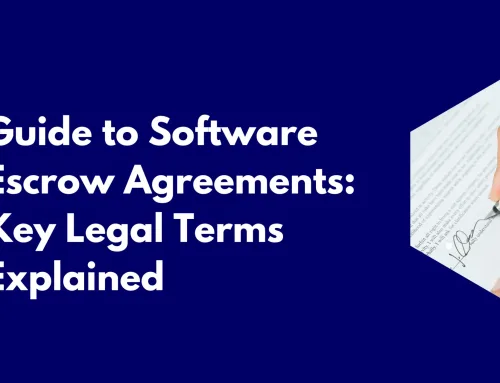As we approach 2025, the tech industry stands on the cusp of significant transformation. A myriad of challenges and opportunities are emerging, setting the stage for what promises to be a dynamic year for the world and the use of technology. In our evolving landscapes, trends such as increasing insolvencies among software companies, consolidation of software vendors, heightened compliance requirements and the accelerated adoption of today’s biggest buzzword artificial intelligence (AI) will shape the future of the industry. In this context, what role will Software and SaaS Escrow play in mitigating risks.
Rise in Insolvencies
Globally, the tech sector is witnessing a worrying trend: a continued rise in insolvencies among software companies. As markets evolve, access to funding has become challenging and competition intensifies, many firms struggle to maintain financial stability. Key international markets have seen substantial forecasts indicating higher bankruptcy rates generally but also in the technology industry. In the UK according to the Company Insolvency Statistics, one in 179 companies on the Companies House effective register (at a rate of 55.8 per 10,000 companies) entered insolvency between 1 July 2023 and 30 June 2024. This was an increase from the 55.1 per 10,000 companies that entered insolvency in the 12 months ending 30 June 2023. In addition, the annual ASIC insolvency data for Australia revealed that 11,000 companies entered external administration for the first time in 2023-24. Within the USA, data from the American Bankruptcy Institute showed that bankruptcy filings (commercial chapter 11 filings) increased 26 percent to 734 in September 2024 from the 585 filings recorded in September 2023. With a worrying rate of companies that entered into insolvency, software escrow is becoming more important to protect business assets and investments. At Escrow London / The Escrow Company, we have seen a dramatic increase in software escrow triggers. In previous years, we would handle 1 or 2 escrow triggers per year, in 2024, this has increased to 1 or 2 triggers per month.
Consolidation of Suppliers
In a bid to reduce costs and streamline operations, customers are increasingly consolidating their supplier base. This trend places pressure on suppliers to present themselves as stable, reliable entities in conjunction with adding significant value in order for customers to renew. Establishing software escrow procedures can enable suppliers to build trust with their clients by assuring them of ongoing access to crucial software, regardless of any unforeseen circumstances. By offering such guarantees, suppliers can not only maintain customer confidence but also foster long-term relationships that are crucial in a competitive market.
Increased Compliance Requirements
Another significant and well documented trend that’s happened over the past few years and will continue in 2025 and beyond is the surge in compliance requirements, especially for regulated financial markets. The Digital Operational Resilience Act (DORA) coming into force across the EU market in January, represents a cornerstone of this regulatory pressure, emphasizing the importance of operational resilience in financial markets and to the functioning of our global economy. Regulators aim to keep up with financial institutions’ increased demand for cloud based and third party solutions required for speed and agility. The regulated markets strive for resilience will permeate into other sectors as best practices in time will flow down the chain and the importance of digital solutions grows within modern society.
Adoption of Artificial Intelligence
Following on from the exponential adoption of AI technology in 2024, all indicators show there will be a substantial increase in AI adoption into 2025. Transforming business processes across various sectors and companies without an AI go to market strategy might get left behind. The accelerating focus and investment by companies in AI could divert funds from other potential business projects, tightening market conditions for software vendors and slowing down growth as companies figure out how they can best deploy capital. In addition, the EU AI Act is the first regulation on artificial intelligence and government have attempted to grasp how they can support business demand for efficiencies through AI adoption whilst having safeguards and guidelines for proper use and data management processes. Under the EU AI Act, certain high-risk AI systems are subject to strict regulations, including requirements for transparency, accountability, and auditability.
Escrow for AI Models
As AI continues to proliferate and use cases evolve, governance and management of these solutions will follow. New escrow requirements will emerge, particularly concerning AI models and continuity in the event of disruption. Unlike traditional software, AI systems involve complex models and data sets that must be adequately managed and secured. The use of escrow agreements in this domain can offer a reliable solution for protecting AI models, ensuring their availability and integrity in the event of a vendor’s insolvency or operational disruption. These steps are crucial for companies aiming to realize the full potential of AI while mitigating associated supply chain risks.
Summary
In conclusion, the technology industry in 2025 will be defined by several transformative trends that necessitate proactive strategies. Implementing software escrow solutions will be vital for companies looking to safeguard their most critical solutions from severe disruption and comply with these increasing demands. Ensuring that companies have the necessary business continuity plans and adherence to regulatory frameworks. Software escrow provisions provide an effective mechanism to address emerging industry challenges, offering organisations the security and resilience needed to thrive in a rapidly changing technological landscape. As the industry continues to evolve, embracing software escrow will be pivotal in navigating the complex terrain ahead.








